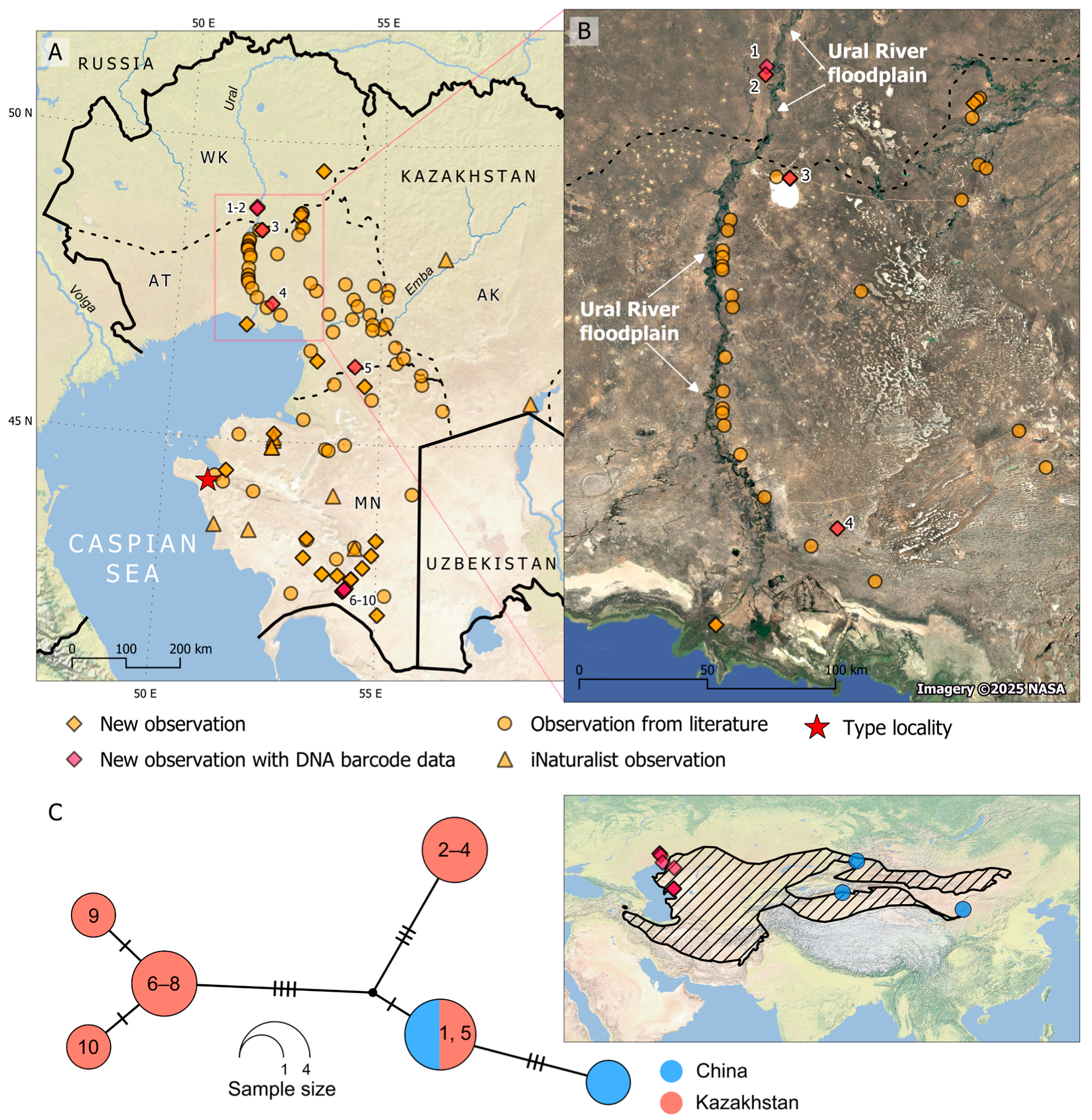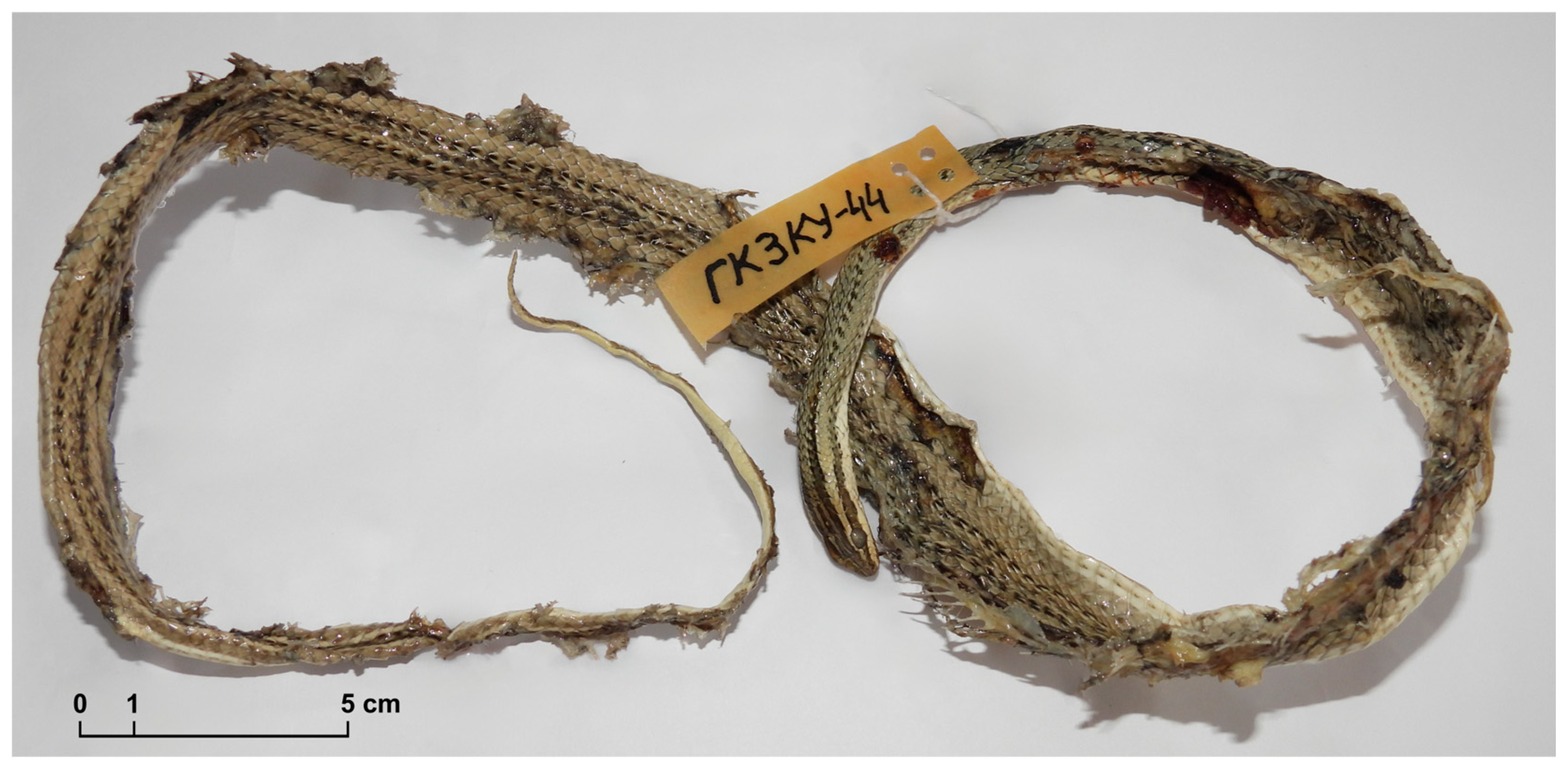First European Occurrence and Genetic Diversity of the Steppe Ribbon Racer Psammophis lineolatus (Brandt, 1838) (Serpentes: Psammophiidae)
Abstract
1. Introduction
2. Materials and Methods
3. Results
4. Discussion
Supplementary Materials
Author Contributions
Funding
Institutional Review Board Statement
Data Availability Statement
Acknowledgments
Conflicts of Interest
References
- Speybroeck, J.; Beukema, W.; Dufresnes, C.; Fritz, U.; Jablonski, D.; Lymberakis, P.; Martínez-Solano, I.; Razzetti, E.; Vamberger, M.; Vences, M.; et al. Species list of the European herpetofauna—2020 update by the Taxonomic Committee of the Societas Europaea Herpetologica. Amphib. Reptil. 2020, 41, 139–189. [Google Scholar] [CrossRef]
- Gasc, J.-P.; Cabela, A.; Crnobrnja-Isailovic, J.; Dolmen, D.; Grossenbacher, K.; Haffner, P.; Lescure, J.; Martens, H.; Martínez-Rica, J.P.; Maurin, H.; et al. Atlas of Amphibians and Reptiles in Europe; Muséum National D’histoire Naturelle: Paris, France, 1997. [Google Scholar]
- Sillero, N.; Campos, J.; Bonardi, A.; Corti, C.; Creemers, R.; Crochet, P.-A.; Crnobrnja Isailovic, J.; Denoël, M.; Ficetola, G.F.; Gonçalves, J.; et al. Updated distribution and biogeography of amphibians and reptiles of Europe. Amphib. Reptil. 2014, 35, 1–31. [Google Scholar] [CrossRef]
- Tockner, K.; Zarfl, C.; Robinson, C. Rivers of Europe, 2nd ed.; Elsevier: Amsterdam, The Netherlands, 2022. [Google Scholar]
- Sindaco, R.; Venchi, A.; Cristina Grieco, C. The Reptiles of the Western Palearctic, Volume 2: Annotated Checklist and Distributional Atlas of the Snakes of Europe, North Africa, Middle East and Central Asia, with an Update to Volume 1; Edizioni Belvedere: Latina, Italy, 2013. [Google Scholar]
- Doronin, I.V. A new record of the steppe ribbon racer, Psammophis lineolatus (Brandt, 1836) (Serpentes: Lamprophiidae) in the Caucasus. Curr. Stud. Herpetol. 2016, 16, 161–163. (In Russian) [Google Scholar] [CrossRef]
- Sarayev, F.A. Distribution of the steppe ribbon racer Psammophis lineolatus (Brandt, 1838) in the North-Eastern Caspian region. In Proceedings of the 2nd International Conference Dedicated to the Memory of the Outstanding Naturalist and Traveler Nikolai Alekseevich Zarudny “Spatial-Temporal Dynamics of Biota and Ecosystems of the Aral-Caspian Basin”, Orenburg, Russia, 9–13 October 2017. (In Russian). [Google Scholar]
- Akhmedenov, K.M.; Bakiev, A.G. The Steppe Ribbon Racer Psammophis lineolatus (Brandt, 1838) (Serpentes: Lamprophiidae) in Mangistau and Atyrau oblasts from the Republic of Kazakhstan. Tr. Inst. Zool. RK 2021, 1, 29–36. (In Russian) [Google Scholar] [CrossRef]
- Wu, Y.; Hou, S.; Yuan, Z.; Jiang, K.; Huang, R.; Wang, K.; Liu, Q.; Yu, Z.; Zhao, H.; Zhang, B.; et al. DNA barcoding of Chinese snakes reveals hidden diversity and conservation needs. Mol. Ecol. Resour. 2023, 23, 1124–1141. [Google Scholar] [CrossRef] [PubMed]
- Chen, M.; Liu, J.; Li, J.; Wu, N.; Guo, X. Complete mitochondrial genome of the steppe ribbon racer (Psammophis lineolatus): The first representative from the snake family Psammophiidae and its phylogenetic implications. Asian Herpetol. Res. 2021, 12, 295–307. [Google Scholar]
- Chen, M.; Liu, J.; Cai, B.; Li, J.; Wu, N.; Guo, X. A new species of Psammophis (Serpentes: Psammophiidae) from the Turpan Basin in northwest China. Zootaxa 2021, 4974, 116–134. [Google Scholar] [CrossRef] [PubMed]
- Doronin, I.V.; Dujsebayeva, T.N.; Akhmedenov, K.M.; Bakiev, A.G.; Plakhov, K.N. On the type locality of the Steppe Ribbon Racer, Psammophis lineolatus (Brandt, 1838) (Serpentes: Lamprophiidae). Proc. Zool. Inst. Russ. Acad. Sci. 2020, 324, 262–272. (In Russian) [Google Scholar] [CrossRef]
- Sambrook, J.; Fritsch, E.F.; Maniatis, T. Molecular Cloning: A Laboratory Manual, 2nd ed.; Cold Spring Harbor Laboratory Press: Cold Spring Harbor, NY, USA, 1989. [Google Scholar]
- Abramson, N.I.; Petrova, T.V.; Dokuchaev, N.E.; Obolenskaya, E.V.; Lissovsky, A.A. Phylogeography of the gray red-backed vole Craseomys rufocanus (Rodentia: Cricetidae) across the distribution range inferred from nonrecombining molecular markers. Russ. J. Theriol. 2012, 11, 137–156. [Google Scholar] [CrossRef]
- Gouy, M.; Guindon, S.; Gascuel, O. SeaView Version 4: A multiplatform graphical user interface for sequence alignment and phylogenetic tree building. Mol. Biol. Evol. 2010, 27, 221–224. [Google Scholar] [CrossRef] [PubMed]
- Tamura, K.; Stecher, G.; Kumar, S. MEGA11: Molecular evolutionary genetics analysis version 11. Mol. Biol. Evol. 2021, 38, 3022–3027. [Google Scholar] [CrossRef] [PubMed]
- Clement, M.; Posada, D.; Crandall, K.A. TCS: A computer program to estimate gene genealogies. Mol. Ecol. 2000, 9, 1657–1659. [Google Scholar] [CrossRef] [PubMed]
- Vences, M.; Patmanidis, S.; Schmidt, J.-C.; Matschiner, M.; Miralles, A.; Renner, S.S. Hapsolutely: A user-friendly tool integrating haplotype phasing, network construction, and haploweb calculation. Bioinforma. Adv. 2024, 4, vbae083. [Google Scholar] [CrossRef] [PubMed]
- Brushko, Z.K.; Kubykin, R.A. Distribution and ecology of the steppe ribbon racer (Psammophis lineolatus Brandt, 1838) in Kazakhstan. Selevinia 2000, 1–4, 130–137. (In Russian) [Google Scholar]
- Sarayev, F.A.; Pestov, M.V. On the Cadaster of the Reptiles of Northern and North Eastern Caspian Sea Region. In Herpetological Researches in Kazakhstan and Adjacent Countries; Association for the Conservation of Biodiversity of Kazakhstan—Birds Conservation Union of Kazakhstan: Almaty, Kazakhstan, 2010; pp. 172–191. (In Russian) [Google Scholar]
- Pestov, M.V.; Sarayev, F.A.; Ageyev, V.S. New Reptile Findings in the Northeastern Precaspian Lowland (Republic of Kazakhstan). Curr. Stud. Herpetol. 2011, 11, 192–195. (In Russian) [Google Scholar]
- Kubykin, R.A.; Plakhov, K.N. On the fauna of amphibians and reptiles of the Aral-Caspian watershed (based on the materials of the expeditions of R.A. Kubykin in 1989–1990). Selevinia 2012, 20, 66–76. (In Russian) [Google Scholar]
- QGIS Development Team. QGIS Geographic Information System. Open Source Geospatial Foundation. 2023. Available online: http://qgis.org/ (accessed on 23 September 2023).
- IUCN (International Union for Conservation of Nature) and Conservation International 2016. Psammophis lineolatus. The IUCN Red List of Threatened Species. Version 2025-1. Available online: https://www.iucnredlist.org/ (accessed on 6 August 2025).
- Georgalis, G.L.; Szyndlar, Z. First occurrence of Psammophis (Serpentes) from Europe witnesses another Messinian herpetofaunal dispersal from Africa—Biogeographic implications and a discussion of the vertebral morphology of psammophiid snakes. Anat. Rec. 2022, 305, 3263–3282. [Google Scholar] [CrossRef] [PubMed]
- Brushko, Z.K.; Kubykin, R.A. Catalog of the Herpetological Collection of the Institute of Zoology of the Academy of Sciences of the Kazakh SSR; Nauka: Alma-Ata, USSR, 1988. (In Russian) [Google Scholar]
- Karelin, G.S. Travels of G.S. Karelin across the Caspian Sea. Mem. Imp. Russ. Geogr. Soc. 1883, 10, 6+497. (In Russian) [Google Scholar]
- Neruchev, V.V.; Shatilovich, O.A. About some patterns of herpetofauna formation in the North-Eastern Caspian region. In Proceedings of the 6th All-Union Herpetological Conference, Leningrad, USSR, 18–20 September 1985; pp. 147–148. (In Russian). [Google Scholar]
- Pestov, M.V.; Saraev, F.A. Nest Discoveries of Some Birds of Prey on the Akkeregeshin Chalk Plateau, Atyrau District, Kazakhstan. Feather. Predat. Their Prot. 2009, 15, 132–133. (In Russian) [Google Scholar]
- Neruchev, V.V.; Shiryaev, A.F.; Kapustina, S.F.; Kudakina, E.Y. Fauna and landscape complexes of reptiles in the south of the Ural-Emba interfluve. In Terrestrial and Aquatic Ecosystems; Publishing House of the Gor’kiy State University: Gor’kiy, USSR, 1984; pp. 86–91. (In Russian) [Google Scholar]
- Nikolsky, A.M. Fauna of Russia and Neighboring Countries, Mainly from the Collections of the Zoological Museum of the Imperial Academy of Sciences. Reptiles (Reptilia). Volume 2. Ophidia; Printing House of the Imperial Academy of Sciences: Petrograd, Russia, 1916. (In Russian) [Google Scholar]
- Ostroumoff, A. Zoological excursion to the Mangishlak and Buzachi peninsulas. Append. Protoc. Meet. Soc. Nat. Imp. Kazan Univ. 1889, 113, 1–18. (In Russian) [Google Scholar]
- Paraskiv, K.P. Reptiles of Kazakhstan; Publishing House of the Academy of Sciences of the Kazakh SSR: Alma-Ata, USSR, 1956. (In Russian) [Google Scholar]


| Locality ID | Locality | Latitude | Longitude | GenBank Accession Number/Sample ID | Reference |
|---|---|---|---|---|---|
| 1 | WK, Kazakhstan | 48.8972 | 51.7849 | PX120880/KZ434 * | This study |
| 2 | WK, Kazakhstan | 48.8688 | 51.7813 | PX120881/KZ436 | This study |
| 3 | North shore of lake Inder, AT, Kazakhstan | 48.5128 | 51.9456 | PX120873/KZ100 | This study |
| 4 | Karabatano train station, AT, Kazakhstan | 47.2972 | 52.3098 | PX120872/KZ32 | This study |
| 5 | 10 km N of Boranqul, AT, Kazakhstan | 46.3103 | 54.3846 | PX120874/KZ188 | This study |
| 6 | Ustyurt National Reserve, MN, Kazakhstan | 42.5634 | 54.2603 | PX120875/KZ227 | This study |
| 7 | Ustyurt National Reserve, MN, Kazakhstan | 42.5701 | 54.2629 | PX120876/KZ240 | This study |
| 8 | Ustyurt National Reserve, MN, Kazakhstan | 42.5954 | 54.2965 | PX120877/KZ245 | This study |
| 9 | Ustyurt National Reserve, MN, Kazakhstan | 42.5950 | 54.2992 | PX120878/KZ246 | This study |
| 10 | Ustyurt National Reserve, MN, Kazakhstan | 42.5972 | 54.2994 | PX120879/KZ249 | This study |
| - | Helan Shan, Ningxia, China | ~38.0 | ~106.0 | OQ416684/KIZ YPX19277 | [9] |
| - | Luntai, Xinjiang, China | ~42.0 | ~84.5 | OQ416685/KIZ 015468 | [9] |
| - | Buerjin County, Xinjiang, China | 47.5593 | 87.0565 | MT991050/GXG311 | [10] |
Disclaimer/Publisher’s Note: The statements, opinions and data contained in all publications are solely those of the individual author(s) and contributor(s) and not of MDPI and/or the editor(s). MDPI and/or the editor(s) disclaim responsibility for any injury to people or property resulting from any ideas, methods, instructions or products referred to in the content. |
© 2025 by the authors. Licensee MDPI, Basel, Switzerland. This article is an open access article distributed under the terms and conditions of the Creative Commons Attribution (CC BY) license (https://creativecommons.org/licenses/by/4.0/).
Share and Cite
Akhmedenov, K.; Bakiev, A.; Klenina, A.; Lukonina, S.; Simonov, E. First European Occurrence and Genetic Diversity of the Steppe Ribbon Racer Psammophis lineolatus (Brandt, 1838) (Serpentes: Psammophiidae). Taxonomy 2025, 5, 54. https://doi.org/10.3390/taxonomy5040054
Akhmedenov K, Bakiev A, Klenina A, Lukonina S, Simonov E. First European Occurrence and Genetic Diversity of the Steppe Ribbon Racer Psammophis lineolatus (Brandt, 1838) (Serpentes: Psammophiidae). Taxonomy. 2025; 5(4):54. https://doi.org/10.3390/taxonomy5040054
Chicago/Turabian StyleAkhmedenov, Kazhmurat, Andrey Bakiev, Anastasia Klenina, Svetlana Lukonina, and Evgeniy Simonov. 2025. "First European Occurrence and Genetic Diversity of the Steppe Ribbon Racer Psammophis lineolatus (Brandt, 1838) (Serpentes: Psammophiidae)" Taxonomy 5, no. 4: 54. https://doi.org/10.3390/taxonomy5040054
APA StyleAkhmedenov, K., Bakiev, A., Klenina, A., Lukonina, S., & Simonov, E. (2025). First European Occurrence and Genetic Diversity of the Steppe Ribbon Racer Psammophis lineolatus (Brandt, 1838) (Serpentes: Psammophiidae). Taxonomy, 5(4), 54. https://doi.org/10.3390/taxonomy5040054






